1. Controversy Surrounding ECI Appointments and Election Transparency – Polity
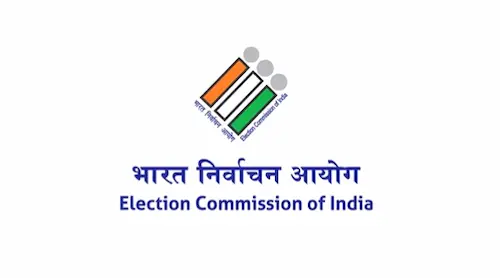
Why in News?
The 2023 Election Commissioners Appointment Act and the transparency of the electoral process, particularly during the 2024 Maharashtra Vidhan Sabha elections, have come under scrutiny. The issue has sparked a constitutional and democratic debate, particularly regarding judicial exclusion, executive dominance, and limited electoral transparency.
Key Constitutional and Legal Issues:
1. Composition of the Selection Committee:
- Under the 2023 Act, the Prime Minister, Union Home Minister, and Leader of Opposition in Lok Sabha form the selection committee.
- This gives the executive a 2:1 majority, raising concerns about lack of neutrality and politicisation of ECI appointments.
2. Exclusion of the Chief Justice of India (CJI):
- The Supreme Court’s March 2023 directive recommended including the CJI in the panel to ensure impartiality.
- However, the Act omits this recommendation, weakening the judicial oversight over the process.
3. Conflict of Interest:
- The same political leadership that contests elections also selects the Election Commissioners, creating a conflict of interest.
- This undermines the impartiality and independence of the ECI—key to maintaining democratic legitimacy.
Concerns About Electoral Transparency:
1. Access to Form 17C:
- Form 17C records votes polled and turnout data.
- It is accessible only to certain candidates, restricting public and independent verification.
- This leads to questions about electoral integrity and public trust in EVM-based voting.
2. Lack of Public Debate and Consultation:
- The Act was passed with minimal parliamentary debate, which civil society groups see as executive overreach.
- Raises red flags regarding transparency, consultation, and democratic due process.
3. Pending Legal Challenge:
- The new Act is under judicial review in the Supreme Court.
- Petitioners argue it violates Article 324 of the Constitution, which vests the superintendence of elections with the ECI, implying the need for its independence.
Role of the Supreme Court:
- In its March 2023 ruling, the SC emphasized that a fair appointment process is central to free and fair elections.
- The Court has taken the stance that the judiciary must act as a guardian of constitutional checks and balances, especially in the absence of enabling legislation by Parliament.
Proposed Reforms for Electoral Transparency:
- Revise the ECI Appointment Process to include CJI or a retired judge for neutrality.
- Public Access to Form 17C for full transparency and confidence in vote counting.
- Independent Audits of Electoral Rolls and EVM functioning to ensure accuracy.
- Strengthening Public Trust in democratic institutions through open processes.
Summary
- The 2023 Election Commissioners Appointment Act gives the ruling executive dominance in the selection of ECI members, excluding judicial oversight.
- Form 17C’s limited access undermines electoral transparency.
- The Act bypassed adequate public or parliamentary debate and is currently being challenged in the Supreme Court.
- The reforms proposed include judicial inclusion in appointments, greater data transparency, and audits to safeguard democracy.
Exam Connect – Possible Questions
Prelims
- Which Article of the Indian Constitution provides for the Election Commission of India?
a) Article 320
b) Article 321
c) Article 324
d) Article 326
Answer: c) Article 324 - Form 17C, often in news, is related to:
a) Land acquisition records
b) Criminal case registration
c) Electoral voting and counting data
d) Income tax disclosures
Answer: c) Electoral voting and counting data - According to the 2023 Act on ECI appointments, the selection committee comprises:
a) PM, CJI, and Leader of Opposition
b) PM, Home Minister, and CJI
c) PM, Home Minister, and Leader of Opposition
d) President, PM, and CJI
Answer: c) PM, Home Minister, and Leader of Opposition
Mains
- Critically examine the impact of the 2023 Election Commissioners Appointment Act on the independence and neutrality of the Election Commission of India.
- “Transparency and public trust are the cornerstones of a vibrant democracy.” In this context, discuss the role of Form 17C and the need for electoral reforms in India.
- Do you think the exclusion of the judiciary from the ECI selection committee undermines the separation of powers enshrined in the Constitution? Justify your answer with recent developments.
2. Chandigarh Leads, Meghalaya Trails in School Education Rankings 2023–24 – Governance
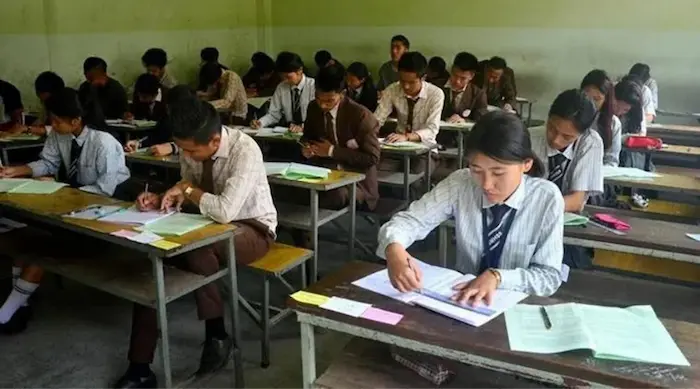
Why in News?
The Performance Grading Index (PGI) 2.0 for the academic year 2023–24 has been released by the Ministry of Education, ranking Chandigarh, Punjab, and Delhi as the top performers in school education, while states like Meghalaya, Bihar, and Assam have lagged behind.
Key Highlights of PGI 2.0 Report:
1. Top Performers:
- Chandigarh, Punjab, and Delhi scored 719 points, placing them in the Prachesta-I grade.
- Prachesta-I is the fifth-highest performance level in PGI 2.0 (Score range: 701–760).
2. Bottom Performers:
- States like Bihar, Assam, and Meghalaya were placed in the lowest performance category – Akanshi-3.
- Reasons: High dropout rates, poor infrastructure, and limited learning outcomes.
3. Mid-Level Performers:
- Fourteen states, including Tamil Nadu and Karnataka, fell under Akanshi-I, indicating moderate performance but with ample room for improvement.
4. Improvement Trends:
- Bihar and Telangana showed positive trends in areas such as student enrollment, infrastructure enhancement, and governance mechanisms.
What is the Performance Grading Index (PGI)?
- Objective: To provide data-driven insights and promote evidence-based policy reforms in school education.
- Scope: Covers all States and Union Territories (UTs).
- Domains Assessed:
- Learning Outcomes
- Access to Education
- Infrastructure & Facilities
- Equity
- Governance Processes
- Teacher Education and Effectiveness
- PGI 2.0 Scoring System:
- Utkarsh (Top Grade): Not yet achieved by any State/UT.
- Prachesta Grades (I to III): Reflect higher-to-mid performance.
- Akanshi Grades (I to III): Reflect lower performance levels.
Significance of PGI 2.0 for Governance:
- Promotes competitive federalism and accountability among states.
- Helps identify gaps and targeted interventions in educational policy.
- Encourages evidence-based governance and reform in public service delivery.
Summary
- PGI 2.0 assesses school education quality across six domains.
- Chandigarh, Punjab, and Delhi top the list (Prachesta-I), while Meghalaya, Bihar, and Assam rank lowest (Akanshi-3).
- Despite progress in some states, no state has yet reached the topmost grade (Utkarsh), indicating ongoing challenges in ensuring holistic educational development.
- The PGI acts as a diagnostic tool to guide education policy and strengthen the governance of school systems in India.
Exam Connect – Possible Questions
Prelims
- What does the Performance Grading Index (PGI) assess?
a) Higher education standards in universities
b) Vocational training programs
c) Quality of school education across Indian states
d) Mid-day meal implementation
Answer: c) Quality of school education across Indian states - Which of the following states/UTs topped the PGI 2.0 Report for 2023–24?
a) Kerala
b) Himachal Pradesh
c) Chandigarh
d) West Bengal
Answer: c) Chandigarh - Which is the highest performance grade in PGI 2.0 that no state has yet achieved?
a) Prachesta-I
b) Akanshi-I
c) Utkarsh
d) Prayas-II
Answer: c) Utkarsh
Mains
- “The Performance Grading Index (PGI) provides critical insights into the state of school education in India.” Discuss its utility and limitations as a tool for educational governance.
- Despite the launch of PGI, several states continue to lag in school education outcomes. Identify key reasons and suggest policy interventions to bridge the performance gap.
- What are the implications of PGI 2.0 findings on cooperative and competitive federalism in the education sector?
3. SMILE Scheme – Support for Marginalised Individuals for Livelihood and Enterprise – Governance
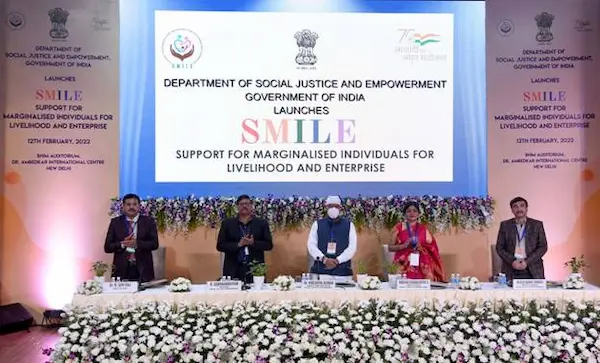
Why in News?
Reasi is set to become the second district in Jammu and Kashmir, after Srinagar, to implement the SMILE Scheme, focusing on the rehabilitation and livelihood development of marginalised groups, especially transgender persons and urban beggars.
Key Features of the SMILE Scheme:
1. Launched:
- In 2022 by the Ministry of Social Justice and Empowerment (MoSJE).
2. Nature of the Scheme:
- Central Sector Scheme (fully funded by the Central Government).
3. Target Beneficiaries:
- Urban beggars, homeless persons, and particularly transgender individuals.
- The scheme aims to benefit approximately 60,000 individuals.
4. Core Objectives:
- Livelihood support, skill development, and social reintegration.
- Restoration of dignity and economic self-reliance.
Key Components of the Scheme:
Shelter and Safety:
- Uses existing shelter homes operated by States/UTs.
- New shelters to be created where gaps exist.
Livelihood and Skill Development:
- Includes vocational training, identity documentation, education, and financial linkages.
- Goal: Promote self-employment and mainstream inclusion.
Field Implementation:
- Pilot phase launched in 30 cities; expanded to 50 additional cities in Phase 2.
- Each city/district unit aims to rehabilitate at least 25 individuals.
Funding:
- ₹100 crore allocated for 2023–26.
- ₹14.71 crore spent by December 2024 on rehabilitation and skilling programs.
Administrative Significance and Challenges:
- Promotes inclusive governance by addressing needs of the most invisible and excluded communities.
- Faces challenges such as:
- Social stigma, especially for transgender persons.
- Identification and tracking of urban beggars.
- Need for community participation and NGO collaboration for success.
Social Impact and Vision:
- Aligned with the goals of SDG 1 (No Poverty) and SDG 10 (Reduced Inequalities).
- Encourages community reintegration, economic empowerment, and human dignity.
- Represents a rights-based approach to rehabilitation and inclusion.
Summary
- The SMILE Scheme (2022) is a Central Sector Scheme aimed at rehabilitating urban beggars and transgender individuals through shelter, skilling, and livelihood support.
- Reasi (J&K) is the latest district to adopt the scheme.
- The scheme integrates previous fragmented efforts into a comprehensive, rights-based framework.
- With a budget of ₹100 crore, it supports urban local bodies and NGOs in building inclusive communities.
Exam Connect – Possible Questions
Prelims
- The SMILE Scheme was launched by which Ministry?
a) Ministry of Women and Child Development
b) Ministry of Social Justice and Empowerment
c) Ministry of Labour and Employment
d) Ministry of Home Affairs
Answer: b) Ministry of Social Justice and Empowerment - Which of the following groups are primarily targeted under the SMILE Scheme?
a) Elderly and widows
b) Street children and orphans
c) Transgender persons and urban beggars
d) Rural unemployed youth
Answer: c) Transgender persons and urban beggars - The SMILE Scheme is classified under which type of government scheme?
a) Centrally Sponsored Scheme
b) State Sector Scheme
c) Central Sector Scheme
d) Public-Private Partnership Scheme
Answer: c) Central Sector Scheme
Mains
- “India’s welfare architecture must go beyond poverty alleviation to ensure dignity and inclusion.” In light of this statement, examine the significance and challenges of implementing the SMILE Scheme.
- Critically evaluate the role of the SMILE Scheme in promoting the rights and welfare of transgender persons in India. What more can be done to enhance its outreach and effectiveness?
- Discuss the importance of livelihood-based rehabilitation schemes in addressing the root causes of urban homelessness and begging in India. Illustrate with examples.
4. PM-WANI Scheme – Public Wi-Fi for All – Economy
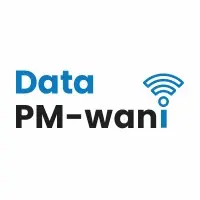
Why in News?
The Telecom Regulatory Authority of India (TRAI) has issued new price guidelines for Wi-Fi hotspot operators under the PM-WANI scheme, capping charges at no more than twice the residential broadband cost. This aims to ensure affordability and accessibility of public internet services across India.
What is PM-WANI?
Full Form:
PM-WANI = Prime Minister Wi-Fi Access Network Interface
Launched:
December 2020 by the Department of Telecommunications (DoT) under the Ministry of Communications.
Objective:
- To democratize internet access, especially in remote, rural, and underserved areas.
- Supports the National Digital Communications Policy, 2018.
- Promotes digital inclusion, entrepreneurship, and public service delivery.
How PM-WANI Works – Key Components:
The PM-WANI ecosystem has four main stakeholders:
- Public Data Office (PDO):
- Sets up Wi-Fi hotspots.
- Sells internet access to users.
- Can be run by small businesses or rural entrepreneurs.
- Public Data Office Aggregator (PDOA):
- Manages authorization and billing for PDOs.
- Provides backend support and security.
- App Provider:
- Offers an app to users to locate and connect to nearby PDOs.
- Facilitates user onboarding.
- Central Registry:
- Maintained by the Centre for Development of Telematics (C-DoT).
- Stores database of all registered PDOs, PDOAs, and App Providers.
Implementation Mechanism:
- Users download the PM-WANI App to view and connect to available public hotspots.
- No SIM card is required—ensuring greater accessibility for all demographics.
- PDOs typically operate in public places like railway stations, post offices, banks, etc.
- Rural entrepreneurs can purchase bandwidth from ISPs at low cost and resell Wi-Fi, creating local employment and increasing internet penetration.
TRAI’s Latest Guideline (2025):
- Wi-Fi operators under PM-WANI cannot charge more than twice the cost of residential broadband for setting up a hotspot.
- Ensures affordability, prevents exploitation, and supports universal digital access.
Benefits and Significance:
| Area | Impact |
|---|---|
| Digital Inclusion | Bridges rural-urban internet divide |
| Entrepreneurship | Encourages local enterprises to become PDOs |
| Public Service Delivery | Enables e-governance, digital education, and telemedicine |
| Employment | Empowers rural youth to run sustainable micro-businesses |
| Affordability | Uses unlicensed spectrum (Wi-Fi) to lower costs significantly |
Summary
- PM-WANI is a public Wi-Fi initiative launched in 2020 to provide low-cost internet access via PDOs in public places.
- TRAI now limits pricing to double the cost of home broadband, promoting affordability.
- Encourages rural entrepreneurship, digital literacy, and access to e-services.
- Supported by the Digital India mission and the National Digital Communications Policy, 2018.
Exam Connect – Possible Questions
Prelims
- What is the primary objective of the PM-WANI Scheme?
a) Promote solar energy generation
b) Provide free SIM cards to rural areas
c) Enable public Wi-Fi access through local entrepreneurship
d) Build data centers in every state
Answer: c) Enable public Wi-Fi access through local entrepreneurship - Which body maintains the Central Registry under the PM-WANI ecosystem?
a) TRAI
b) NIC
c) Centre for Development of Telematics (C-DoT)
d) BSNL
Answer: c) Centre for Development of Telematics (C-DoT) - Under the PM-WANI scheme, who is responsible for setting up and running public Wi-Fi hotspots?
a) PDOA
b) PDO
c) ISP
d) NIC
Answer: b) PDO
Mains
- Discuss the potential of the PM-WANI Scheme in bridging the digital divide in India. What challenges could hinder its successful implementation?
- “Public Wi-Fi is a tool for inclusive digital transformation.” In light of this, analyze the role of PM-WANI in promoting digital entrepreneurship and social equity.
- Evaluate the implications of TRAI’s pricing regulation on the scalability and sustainability of the PM-WANI ecosystem.
5. Legal Mandate for One Nation, One Time (Indian Standard Time – IST) – Governance
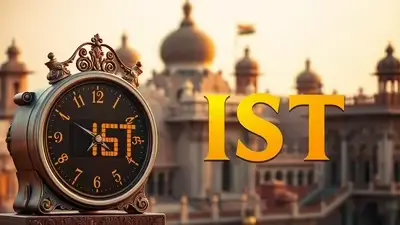
Why in News?
The Government of India has introduced a legal mandate requiring the uniform use of Indian Standard Time (IST) across all sectors—legal, administrative, commercial, and digital—under the new Legal Metrology (IST) Rules, 2025. This move is part of the “One Nation, One Time” initiative aimed at enhancing synchronization and efficiency across the country.
Key Takeaways:
Indian Standard Time (IST):
- Time Zone: UTC +5:30 (i.e., 5 hours 30 minutes ahead of Coordinated Universal Time).
- Established: 1906.
- Maintained by: CSIR–National Physical Laboratory (NPL).
- Reference Meridian: 82.5°E longitude (passes near Mirzapur, Uttar Pradesh).
- Usage: Also followed by Sri Lanka and formerly by Nepal.
No Daylight Saving:
- India does not follow Daylight Saving Time (DST), keeping IST constant throughout the year.
Global Time Standards for Comparison:
| Time Standard | Key Features |
|---|---|
| Greenwich Mean Time (GMT) | Based on solar time at the Prime Meridian (1884). No DST observed. |
| Coordinated Universal Time (UTC) | Modern atomic time standard with leap seconds to match Earth’s rotation. Global reference. |
Implementation Strategy: “One Nation, One Time”
1. Time Dissemination Project:
- Led by the Department of Consumer Affairs, in collaboration with ISRO.
- Goal: Ensure accurate, secure, and synchronized time across all sectors.
- Establishing five Regional Reference Standard Laboratories (RRSLs) in:
- Ahmedabad, Bengaluru, Bhubaneswar, Faridabad, and Guwahati.
2. Legal Metrology (IST) Rules, 2025:
- IST is now the sole legally recognized time standard across India.
- Use of foreign time sources (e.g., NTP servers based abroad) without approval is prohibited.
- Requires all systems (digital, industrial, financial, etc.) to synchronize with IST.
Why This Matters:
| Sector | Benefit |
|---|---|
| Governance | Uniform timekeeping reduces interdepartmental delays and improves record-keeping. |
| Business | Critical for stock markets, e-commerce, and cross-border trade consistency. |
| Digital Infrastructure | Synchronization vital for cybersecurity, authentication, and legal validity. |
| Transportation & Aviation | Real-time coordination across zones and schedules. |
Summary
- The Legal Metrology (IST) Rules, 2025 mandate IST as the only legal time standard in India.
- Part of the broader “One Nation, One Time” initiative, this reform promotes administrative uniformity and digital synchronization.
- India will establish regional time labs to support secure time dissemination via ISRO-backed tech.
- Prohibits unauthorized use of foreign time servers, improving cybersecurity and data accuracy.
Exam Connect – Possible Questions
Prelims
- Indian Standard Time (IST) is based on which longitude?
a) 90°E
b) 82.5°E
c) 75°E
d) 88°E
Answer: b) 82.5°E - Which institution is responsible for maintaining Indian Standard Time (IST)?
a) ISRO
b) NITI Aayog
c) CSIR – National Physical Laboratory
d) Ministry of Electronics and IT
Answer: c) CSIR – National Physical Laboratory - Which of the following statements is correct about the Legal Metrology (IST) Rules, 2025?
a) Allows use of any international time server freely.
b) Mandates synchronization with GMT for legal systems.
c) Prohibits foreign time sources without approval.
d) Introduces daylight saving time in India.
Answer: c) Prohibits foreign time sources without approval.
Mains
- Discuss the rationale and potential impact of the “One Nation, One Time” initiative on governance, digital security, and economic efficiency in India.
- How does standardizing time under the Legal Metrology (IST) Rules, 2025 contribute to India’s e-governance and national integration efforts?
- Compare IST with global time standards like UTC and GMT. What are the benefits and challenges of maintaining a fixed national time zone for a geographically vast country like India?
6. Resetting the India–U.S. Partnership in Uncertain Times – InternationaI Relations
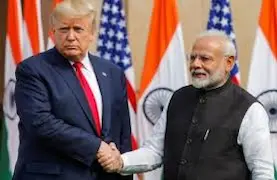
Why in News?
Though once hailed as a “defining partnership of the 21st century”, the India–U.S. relationship is currently experiencing strategic drift, marked by growing distrust, policy friction, and geopolitical recalibrations. Analysts and diplomats are calling for a strategic reset based on mutual respect, economic cooperation, and shared democratic values.
Key Takeaways:
Shift from Optimism to Unease:
- Relationship moved from deep strategic optimism to subtle diplomatic discomfort.
- Driven by unilateral policies, lack of clear communication, and misinterpretation of India’s independent foreign policy.
Core Friction Areas:
| Issue | Explanation |
|---|---|
| Economic Policies | U.S. hesitation in committing long-term investment due to regulatory and market unpredictability in India. |
| Immigration | Uncertainty over H-1B visa policies affects Indian professionals and tech companies. |
| Pakistan Engagement | U.S. military and aid ties with Pakistan continue to raise concerns in New Delhi. |
| Strategic Autonomy | India’s non-alignment and issue-based alignment often misunderstood in Washington as policy drift or indecision. |
Legacy & Current Areas of Cooperation:
Positive Engagements:
- Defense Partnership: COMCASA, BECA, and LEMOA agreements signed; growing arms trade.
- Indo-Pacific & QUAD: Shared interest in counterbalancing China.
- Tech & Digital Economy: U.S. investments in Indian IT and digital infrastructure.
Areas Needing Attention:
- Trade Imbalances: Tariff disputes, digital services taxation, and market access issues.
- Climate Finance: U.S. promises for green funding yet to fully materialize for Indian priorities.
- Public Perception & Media: Miscommunication and politicization of issues (e.g., human rights, religious freedom) fuel mistrust.
Proposed Strategic Reset – Key Recommendations:
- Avoid Reactive Diplomacy: Engage through structured dialogue, not crisis response.
- Accelerate Domestic Reforms: Improve ease of doing business to attract more FDI, especially from U.S. firms.
- Reinforce Shared Democratic Values: Use platforms like the Summit for Democracy to build ideological alignment.
- Focus on Strategic Technology: Collaborate on AI, space, 5G, and semiconductors.
- Institutionalize Strategic Dialogue: High-level annual summits and defense dialogues.
Summary
- India–U.S. ties, once described as natural allies, face strategic stagnation.
- Points of tension include immigration issues, U.S.–Pakistan relations, and economic friction.
- Misreading of India’s strategic autonomy has created policy mismatches.
- Reset strategy includes clear communication, reforms in domestic regulation, and leveraging shared interests in defense and technology.
- A values-based, non-transactional partnership is essential for global democratic alignment and regional stability.
Exam Connect – Possible Questions
Prelims
- Which of the following agreements is NOT part of the India–U.S. foundational defense agreements?
a) LEMOA
b) BECA
c) COMCASA
d) CEPA
Answer: d) CEPA
(CEPA is a trade agreement, not a defense agreement) - The H-1B visa program primarily benefits which sector of India–U.S. relations?
a) Defense
b) Agriculture
c) IT and skilled workforce migration
d) Education
Answer: c) IT and skilled workforce migration - Which of the following is a key multilateral grouping involving India and the U.S. aimed at Indo-Pacific cooperation?
a) SAARC
b) QUAD
c) RCEP
d) OIC
Answer: b) QUAD
Mains
- Despite shared democratic values and strategic interests, the India–U.S. relationship faces recurring challenges. Analyze the causes of this drift and suggest ways to reset the bilateral partnership.
- Discuss the importance of India maintaining its strategic autonomy in the context of evolving relations with major powers like the U.S.
- Evaluate the role of the QUAD in reshaping the India–U.S. partnership and its impact on the Indo-Pacific geopolitical order.

